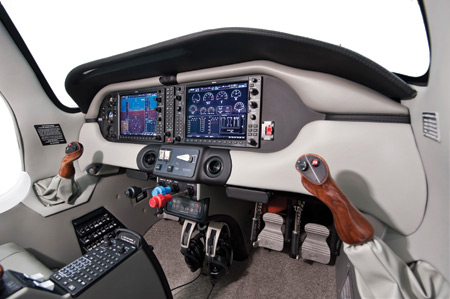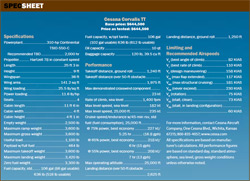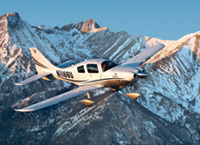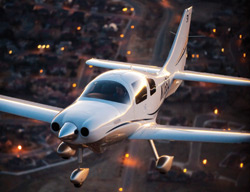Cessna Corvalis TT
A pilot's airplane: Fast, comfortable, and beautiful

Someone at Cessna was fed up. Sure they’ll tell you it was economics, there was a market, and the customers requested it. But there’s no doubt if some Cessna executive is being honest, the jokes hurt. Slowtation. Nearjet. Gutless. There are more.
So they set out to prove the world wrong, and with the Citation X, built the fastest civilian airplane in the world. But the piston line still ruled the slow lane, so when a fledging airplane builder in Oregon couldn’t hang on, Cessna seized on the opportunity and struck quickly. The result is that Cessna now owns the title of both fastest jet manufacturer and maker of the fastest certificated fixed-gear, single-engine airplane available anywhere—the Corvalis TT. And wow, what an airplane.
Despite its controversial name, the Corvalis TT is a piece of airplane art. It’s fast, comfortable, and strikingly beautiful. With its acquisition of Columbia Aircraft, Cessna seized on one of only three contenders in the ultra-fast, high-end single-engine category, and in doing so gained not only respect from the name callers, but also some superb engineering and manufacturing knowledge for projects we’ll only know about as they happen in the future.
The story of the Corvalis TT goes back even before Columbia. Kit-builder and Lancair founder Lance Neibauer, coming off great success with his two-seat models, decided to expand and create a four-seat model, the IV. Soon after, Lancair began working on a simpler, fixed-gear version they called the ES. The ES launched the certificated arm of Lancair called Columbia. And in 1998, the ES was certificated as the Columbia 300. But the Corvalis TT’s real father was born in 2000 as the Columbia 400.
An inefficient production process, fierce competition, and one random act of nature (a hailstorm on the factory ramp) forced Columbia into bankruptcy in 2007. Less than a year later, the slow guys from Wichita owned the almost-made-it composite construction experts from Bend, Oregon.
All that means that customers can have their cake and eat it too—or, more appropriately, have their speed and efficiency, and a nice airplane too. Because while the homebuilt market may produce some astonishingly fast, efficient, and relatively inexpensive aircraft, the idea of Jim or Steve building it in his garage simply doesn’t appeal to many buyers. Cessna, and to a certain extent Columbia before it, has been able to offer an incredible airplane with all the homebuilt benefits, but with the added bonus of being built to a reliable quality standard, factory support, and the peace of mind of certification.
 Click to see the full Spec Sheet.
Click to see the full Spec Sheet.
We had a chance to fly the airplane out of Peter O. Knight Airport in Tampa in advance of AOPA Summit last November. First things first, the airplane has a fantastic ramp presence. The Corvalis is less numerous than its rival Cirrus, so the airplane remains somewhat foreign enough to get looks on the ramp. Aside from that, it’s just a fabulously beautiful airplane. It sits high on a unique forward-swept landing gear, with smooth, flowing lines that lead into control surfaces that seem unremarkably appropriate. It’s not one of those airplanes that you walk up to and think, That tail is huge, or It looks like a pregnant duck. And then those cool gull-wing doors open straight up to an inviting cabin.
Nifty features begin before you even open the doors, though. Remember all those times you fumbled for keys in the rain as you tried to unlock the doors? An included key fob makes that an issue no more. It unlocks the doors and turns on a cabin light, making the Corvalis TT’s open, roomy, and well-equipped cockpit even more inviting. Once you step in, it’s immediately clear this airplane is in an upper class. The formed side stick is made of polished wood, and the lack of yoke means copious amounts
of room in front of the pilot and passenger. Below the center of the panel are two hooks for the pilot and copilot headsets, a seemingly small detail that adds to the finish. And, of course, there are the requisite cup holders no new airplane can escape.
If an aircraft’s cockpit is judged first in terms of space, the Corvalis TT does quite well. The headroom is more than ample, as is the shoulder room. Both are comparable to the Cirrus. The back seats are comfortable, but a little tight. It’s a somewhat moot point, however, as many owners never seem to fill these airplanes with people and bags, even if they could. The baggage compartment is deep and can be made larger thanks to quick-release pins that allow the back seats to fold down.
Once the pilot settles into the left seat, more high-end touches become evident, such as the door that is gently closed, locked neatly, and then sealed with a pneumatic door seal. The right arm rests nicely on the center console, at the end of which is the keypad for the Garmin G1000 integrated flight display. It’s as if one is sitting in an easy chair with the remote in the left hand and a snack in the right. Cirrus makes a point of the fact that its seats move forward and back, while the Corvalis TT’s seats offer only removable cushions and adjustable rudder pedals. The medium- thickness cushion was installed in the test airplane, a thickness I found to give ample headroom, despite my longer-than-average torso. Count that as an issue that’s not.

Fire up the big-bore 310-horsepower TSIO-550C Continental and you’re ready to go. This is the same engine that is found on both the Cirrus and the Mooney Acclaim Type S, but Cessna takes a slightly different tack and uses Continental’s factory turbochargers—one of the biggest benefits of which is that it comes with Continental’s factory five-year warranty.
We barely have the engine started and demo pilot Chris Lee switches on the climate-controlled air conditioning, a standard feature on the airplane that has no use limitations. Buyers in colder climates can order an airplane without it to gain 70 or so pounds of useful load. Personally, I’d rather lose some weight or make my friends drive because it’s just too nice not to have it.
Taxiing out, Lee points out that brake fires haven’t been an issue on the Corvalis TT. Oh, good. Apparently some pilots of this type of high-performance airplane haven’t quite gotten down taxiing with a castering nosewheel, which is admittedly even harder to master than the oft-beleaguered sidestick. To avoid the fire issue, the Corvalis TT has venturis in the fiberglass to direct airflow around the brakes and cool them. It’s those little touches again.
Although Lee said pilots take a few hours to get used to the sidestick, to me, it was more intuitive than a yoke. The control response is so nice it required nary a thought. On takeoff the airplane is a monster, as you would expect it to be. If you hold the brakes and add power you can feel it crouch down, ready to pounce. Which is just too cool.
The airplane ran through altitudes as it climbed 1,500 feet a minute. Anticipating a climb to 17,500 feet, we donned nose cannulas and turned on the oxygen with the simple push of a softkey on the G1000. At this point the Garmin GFC700 did a fine job flying the airplane, so we took a minute to note the numbers as we leveled off near the flight levels. A best-power cruise here gets one 213 knots true at 24.2 gallons an hour. Cessna does all leaning via turbine inlet temperature, which sat at about 1,600 degrees. That corresponds to cylinder head temperatures in the high 300s and exhaust gas temperatures anywhere from the mid-1,400s to 1,500.
Bring the power back to a more normal cruise setting and you’ll slow down to 208 knots true burning 21.4 gallons an hour. The CHTs stayed steady, but EGTs climbed to the low- to mid-1,500s. But this being a Continental, no one runs rich of peak, so the numbers that really matter are the lean-of-peak figures. At 17,500 feet Lee pulled back the mixture and we were burning 16.2 gallons an hour while doing 205 knots true. The temperatures were cooler too, as happens with lean-of-peak operations. Long-range cruise allows for an even more impressive 14.2 gallons an hour at 190 knots true.
Much has been made about the speed of the Corvalis TT, and there’s no doubt it’s a fast airplane. But its top speed of 235 knots at flight level 250 is, like others in its class, more of marketing gimmick than a true measure of airplane greatness. Pilots love to talk about speed, but when it comes to plunking down the cash, a few knots here and there seem to be less important than fuel burn, space, and comfort. That’s evident in the fact that the vast majority of owners are flying in less-efficient lower altitudes, says Lee. But since we are talking about speed, the numbers more or less matched the book, plus or minus a knot or two.
After stretching the airplane’s legs we slowed down a bit and did some air work. Here again, the airplane shined. Push-rod aileron and pitch make it very responsive and a joy to fly. Turns are crisp, and the view out of the large side windows really ups the sensory experience while yanking and banking. The entire flight regime is comfortable and easy, especially slow flight, which the Corvalis TT does better than its little siblings in the single-engine Cessna product line.
 But for all this great flying, the Corvalis TT has one annoying control feature—a rudder hold button in lieu of proper rudder trim. The idea is that the pilot sets the rudder pressure, and then pushes the button to hold that pressure. So, push it once in the climb, once in cruise, and once in the descent if you want to rest your legs. Yes, it works. But unless you’re Baryshnikov, the airplane yaws and banks in the transition just enough to make passengers groan.
But for all this great flying, the Corvalis TT has one annoying control feature—a rudder hold button in lieu of proper rudder trim. The idea is that the pilot sets the rudder pressure, and then pushes the button to hold that pressure. So, push it once in the climb, once in cruise, and once in the descent if you want to rest your legs. Yes, it works. But unless you’re Baryshnikov, the airplane yaws and banks in the transition just enough to make passengers groan.
The only other thing an owner could possibly dislike is the lack of smoothness of the airplane. The Mooney Acclaim Type S is so smooth it feels like you’re in a turboprop. Such is not the case with the Corvalis TT, or at least this Corvalis TT. The vibration wasn’t uncomfortable by any means, but it was noticeable.
When it was time to come down, Lee took the opportunity to show off another of the Corvalis TT’s nice features. Speed brakes come standard, which make for nice, stable 2,000 feet-per-minute descents. So going down and slowing down is never a problem. The best part is that while one should never have them out on landing, the airplane lands just fine with the speed brakes deployed if one forgets. Great landings are a trait of the airplane in general. It takes up a fair amount of runway, but the landings are fantastic, and best of all, easy.
Much of what’s wonderful about the airplane can’t be attributed to Cessna. But one also can’t deny that new airplanes probably wouldn’t be rolling out of the factory if it weren’t for the venerable manufacturer, either. More than anything, Cessna has invested in making the airplane viable in the marketplace. It has significantly streamlined production, building an airplane in almost half the man-hours. Unfortunately for former empolyees, Cessna also closed Columbia’s Bend, Oregon, facility and moved part of it to Independence, Kansas, and part of it to Mexico.
While production gains are the bulk of what Cessna has done, it has made improvements in the airframe and avionics. Most important, Cessna added WAAS to the G1000, which is no small undertaking. It changed the oxygen tanks to reduce weight, improved the paint process, changed the cowling to get rid of some engine heat issues, and worked to continue the TKS anti-icing system as an option. When Columbia owned the type certificate, it placed the bet on an electric hot wing—which was, well, hot. A few burn holes in airplanes later, the FAA issued an AD mandating that owners disable the system. The system was dropped in favor of TKS, but there are indications that there will be more ice protection options in the future, including an improved hot wing.
Much has also been said about Cessna’s investment in the airplane for the composite expertise, which airplane director Mark Withrow said has been invaluable. “We learned a lot from the Bend operation,” he said. “I had to change my school of thought and take my time to understand the process. The first month I just learned, asked questions, and took a lot of notes.” Withrow said that many Bend employees took Cessna’s offer to move to Independence, which helped retain the institutional knowledge. How the company uses that expertise in the future has yet to be determined. “We are taking lessons learned from Bend and integrating them into future designs. When looking at a new design, we’ll have to challenge ourselves and see what is best for our customers and what makes sense.”
For the majority of us, an airplane in this price range is a fantasy. But the folks at Cessna have become masters in offering a complete vertical product line, and the Corvalis TT fills out a large gap in the top end of their singles. So trading up from a 182 to a Corvalis TT doesn’t seem like so big of a jump.
E-mail the author at [email protected].


